Creating a Russian Dacha in the Comforts of Your Own Home
Posted by Women Friends of the Russian Museum on May 19th 2015
So, you have the imagination, taste and good sense to opt for a Russian dacha motif in the comforts of your own home. The first step is to decide which room to magically transform: den, study, guest room, spare bedroom, family room? This done, the process itself is not all that difficult. And, most importantly, it allows for a range of budgets.

To provide an authentic Russian ambiance to the dacha** at the turn of the 19th century, or during the "Silver Age" of Russian culture, you would start with a samovar, or at least plan to add one soon. The samovar was at the heart of Russian life. Around it friends, lovers, relatives and neighbors, laughed, sang and sorrowed; it not only heated water, it warmed one's spirit. In your dacha you need not have a working samovar, it's just the thought that counts. An antique brass one would be best. Don't be tempted to shine it up. Leave the old patina in all its glory.


Use wall space for pictures galore! Especially a picture of a birch tree forest, it reassures you, and others, that you have a soul. Any painting with deep perspective reduces claustrophobia if the dacha is small; perhaps a vast expanse of the Russian steppe with a trans-Siberian steam train in the distance. A fabulous painting of a galloping troika would be great. Include a portrait, or two, of 19th century Russian writers: Dostoevsky, Tolstoy, Chekhov, Pushkin. A picture of churches with golden cupolas, and framed old postcards of architectural wonders from around the world would be superb - Eiffel Tower, Niagara Falls, early American sky scraper, view of London's Big Ben, are all quite appropriate. Leave a place to hang a hand woven wool rug, preferably behind a small ottoman day-bed. It will insulate the occupant from the cold wall and provide a playground for the eyes as you lay daydreaming. If your budget allows, select a large, wonderful red Caucasian, as is the tradition.
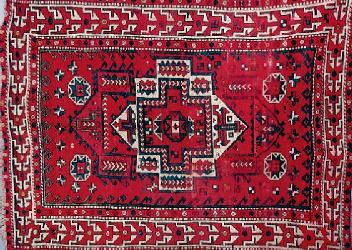
Flowers almost everywhere is a must. Real flowers! If need be, you can cheat a little and settle for silk, but never plastic flowers. Consider using unmatched plates, old, yet fine quality, placed beneath their pots. There is a certain beauty in the unmatched and it will grow on you. Potted palms or a lemon tree near the window would add a nice touch. Regarding smells: be sure they are natural, recognizable, not a strange potpourri named after some celebrity. Use scents you can call by name: lavender, lilac, pine, rose.
If you have a little extra money to spend, consider a good rocking chair, even if you yourself don't care for one or believe that you're too young for one. It belongs in a better dacha as does a small writing desk, the older the better. This is where you would write your poetry, or think about writing poetry. Maybe you would write long letters to friends, or again, just think about writing. Feather pens are optional, just no common plastic ballpoint pens, please! They kill inspiration. Hide them. A bent wood chair would be great. Collect chairs over time so that they are largely unmatched.

An ottoman bed, if there is room, is much better than a common bed or sofa. You can call it a takhta (a carpet-covered backless sofa). You'll put the beautiful red wool rug on the wall just behind it. And on it, maybe a weapon of choice: saber, rifle, dagger or kindjal from Caucasus, none need be of strict Russian origin. Toss on a couple of throw pillows of non-coordinated colors and sizes. Runners on the floor can add warmth and coziness.

You can always use an old, hunch-back trunk that most well-to-do Russian city dwellers owned at the turn of the century, be they intelligentsia, merchants (kooptzy), aristocrats, clergy or better-off peasants. Your local antique dealer or neighborhood garage sale is just the right place to find one. Black and undecorated would provide the most authentic look. It is a soonduke, or soonduchok when it is small and dear to your heart.
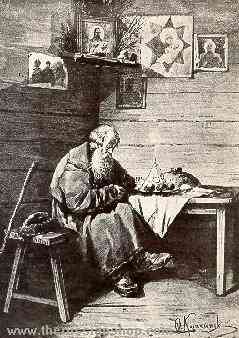
In a Russian Orthodox Christian home, one corner, called the "beautiful" or "holy corner," displays icons. Here, by tradition, a large central icon is draped by a colorful embroidered cloth and graced with a lampada, or vigil lamp burning before it. An analoy, or icon stand, would support a small icon and a bible, or cross.
Let's return to the samovar. Clear glasses kept in glass-holders belong with a samovar. Called podstakanniki, they are the Russian's "teacup". Buy them and use them. They will be admired and your good taste will be complimented. In your dacha, by and large, don't use cups unless you're serving coffee. Mugs, the modern office kind are neutral. However, if there is writing on them they are strictly a "no-no", wrong century. After all, the purpose of your dacha is to take you back; to escape the contemporary, temporarily. For good to very good mental health there is nothing better in this price range.
Serve sugar cubes for tea using silver tongs, if you want to be fancy and historically correct. Otherwise, when serving regular sugar use an interesting spoon and an interesting sugar bowl, even if the cover to it is lost. You might even make a special search for a sugar bowl without its cover at antique or thrift shops. That's also where you'll find interesting teapots. Get a small teapot for brew and a large one for hot water, both with covers. And yes, it's perfectly ok if the covers don't match the pots. What the neighbors think of your tea service is of no consequence. This is a dacha, where you let your hair down. OR, on the other hand...GO BIG! Invest in a Catherine the Great Cobalt Blue Net tea set - currently very popular in the United States, and Europe. It is manufactured in the Imperial Porcelain Factory (formerly Lomonosov Porcelain Factory) located in St. Petersburg, Russia. Splendid porcelain and still affordable.
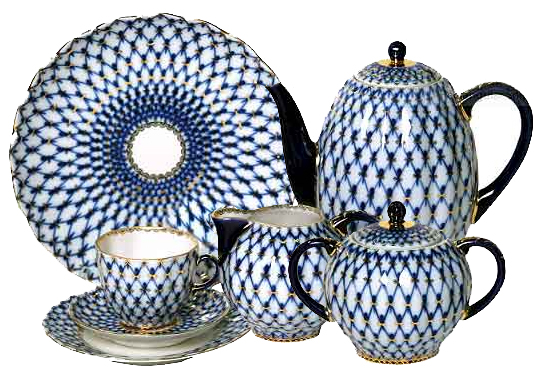
No common water pitcher on your table. A grafin filled with water and glasses turned upside down on a tray is what you want (of course, the tray need not match the grafin.) By the way, a coffee table, as known and used in the West, is not part of a traditional Russian dacha. But do find a place for a suggested good coffee table book: Russian Houses, by Elizabeth Gaynor. Published by: Stewart, Tabori, & Chang 1991.
What else, you may ask? Old enamel dishes and utensils, chipped but interesting. Wooden spoons are great for serving. Unmatched flatware is absolutely fine. Use esoteric, odd or old, but always clean and appetizing, silverware. Or consider the genuine article: antique sterling silverware that you received from your grandmother or purchased from an out-of-the-way antique shop (in which case, be sure to stifle the impulse to search your guests for it on their way out).
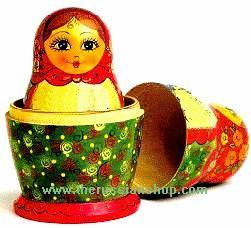
There must be no plastic anywhere in sight. No polyester either. Only the finest in wood, glass, silver, brass, cotton, wool, porcelain, pottery and so forth. Slightly chipped, dented or bent is not out of the question. Wooden bowls, small barrels, knick-knack items of wood, or brass are perfect. A useful wicker basket is OK. To bring it all together, mix in a few traditional Russian Matryoshka Nesting Dolls, several pieces of fiery Golden Khokhloma and a carved wood toy bear from Bogorodsk. A full array of antique objects and collectibles of worldwide origin is quite fitting to display in your dacha. It's the perfect setting for all those wonderful things which you already have. The one good place you can inquire about things you don't have or may need, is The Russian Shop in Lisle, Illinois, among others.
You need a bookshelf with books, even if it's one long straight board on the wall and you don't have time to read. This is where you put Russian classics: War & Peace, Anna Karenina, Crime and Punishment and as well as some books on art, philosophy and religion. There is a rich array of books on "things Russian" and about Russia's culture, history, and the Russian Orthodox Church. A small bookshelf of Russian theological works in English for the general reader may be of potential interest and they are easy to acquire. Before you know it, you can easily have a small Russian home library.
For your comfort, you are free to smuggle a TV, laptop, phone, or any other electronic device, into your dacha. Just hide them behind Chinese screens (they are widely used in Russia but are never called Chinese by the Russians*) and pretend they're not there. If you plan to entertain guests, your music collection may include, from a long, long list of Russian music on old-fashioned record albums or CD, a few well-known favorites: Tchaikovsky's 1812 Overture, Lara's Theme from Dr. Zhivago, Oche Cherniye (Dark Eyes), Moscow Nights, Peter and the Wolf. If you are artistic and devious, you can conceal many excellent Russian videos and CDs inside old book covers with inscriptions on them in Cyrillic letters.
Candlesticks? Good idea. Quite all right with or without candles. Some Russians of the 19th century were anglophiles particularly when it came to candlesticks, or Christmas toys and ornaments. Lamps? Get one or two with chimney glass, be they electric or just decorative, or a real oil lamp, which you need not light. Window curtains? Be on the conservative side. Light, lacy and shear. No bold colors nor heavy drapery; no blinds or shades.
Your dacha has little to do with the food you eat. But just in case you enjoy Russian cooking, a small book will tell you all you need to know. It was written by Russian-American church ladies and tested with American food and measures in mind. Its title is 101 Recipes of Old Russia. It includes recipes for delicious piroshki, pilmeni, borscht, kulich, rum cake and so much more! Ask for it by name.

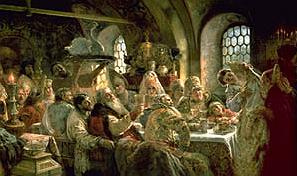
If you know enough about the Romanov Dynasty or its military, several framed photographs of that era will be in order. A small picture of Lermontov in military uniform looks sharp. This is how he is usually pictured: young, dashing, and a poet no less. Russian theatrical posters or reproductions of pre-revolutionary advertising posters might engage your imagination. Don't bother to arrange your pictures symmetrically or such, there is no need to.
Your dacha can evolve at a slow pace almost indefinitely. At some point you probably should consider a copy of a famous Russian painting such as Makovsky's stunning "Boyar's Wedding," or the legendary "Three Bogatyrs" on horseback, much beloved within Russian circles. There are Russian posters that can do so much for your dacha. Anything from Ballet Russe DeMonte Carlo, Pavlovsk or the Bolshoi Theater will create just the right ambiance. Or you may be thinking of a second samovar, a Palekh miniature painting or even Faberge eggs and malachite boxes. But all in all, not to worry. Not like other addictions, you can easily move along and always settle for something else from the huge selection of Russian artifacts without going broke or complaining to yourself that there is not much else you can possibly buy, invest in, or invent and that you just can't think of anything else to do with your dacha, your imagination, your time, your money and yourself. (Quite parenthetically, that long sentence you just read is, as you probably know, very Russian.)
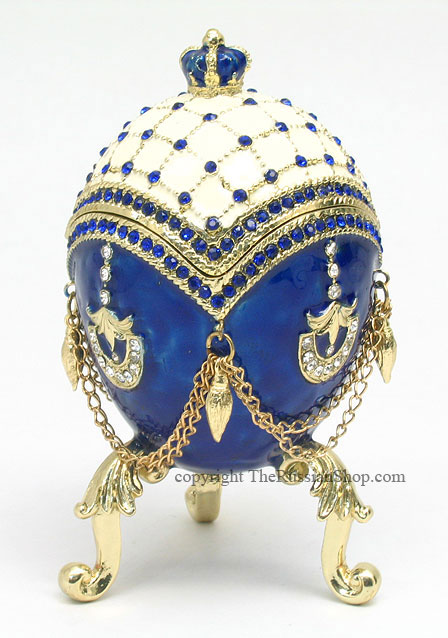
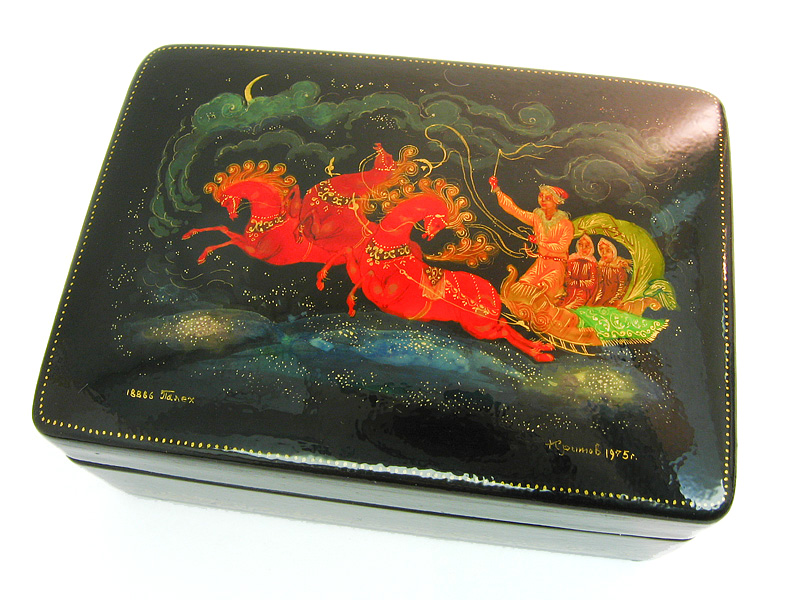
When you think your dacha is finished and you are enjoying it tremendously, only then should you start worrying why your samovar doesn't have a drip bowl (they are generally not easy to get). Remember that your dacha can be decorated with leftovers from your home or found in your grandparents' attic, at antique shops and garage sales. If some guests are unimpressed, so be it, their lack of appreciation has it's own consequences. You owe your guests, be they friends or relatives, only a generous abundance of food and drink set upon the table, good fellowship and deep or pleasant conversation, as is the great Russian tradition. Period. The rest is yours. After all, it's your dacha. The guests are largely left on their own and welcome to be themselves.
The bottom line again is that your dacha can have a very individual character given the depth and width of the Russian culture and its long history.
* In Russia, a Chinese screen is called shirmochka, which, other than having the right playful sound, signifies nothing.
** Dacha is pronounced dah' cha, as in "cha, cha, cha."
RUSSIAN DACHA printed here with kind permission of Women Friends of Russian Museum.

